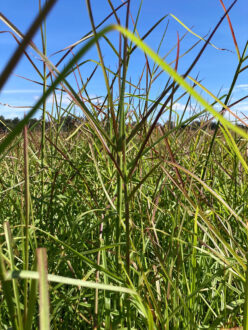MARIANNA, Florida – For Southeast ranchers interested in grazing their beef cattle year-round, winter is the most challenging season for finding supplementing feed after warm-season grasses, like bahiagrass, decline in the fall, but before cool-season forages (oats or rye) are ready in the winter. University of Florida researchers have found a perennial grass that will fill that gap.
Jose Dubeux, a forage agronomist with the North Florida Research and Education Center, says ranchers can stockpile limpograss, a warm-season grass that can be used to satisfy grazing needs roughly between October and January without the need to supplement.
He received a Southern Sustainable Agriculture Research and Education (SSARE) On-Farm Research Grant to assess limpograss growth and nutritive value, develop planting material, and increase knowledge of managing limpograss along the Florida Panhandle, as well as other coastal areas across the South.
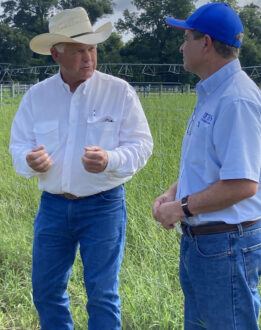
“Limpograss is unique compared to other warm-season grasses. It’s not as light sensitive so it will not go dormant like a bermudagrass or bahiagrass in the fall. It thrives under cool conditions with windows of warm weather and moisture,” said Dubeux. “It doesn’t lose digestibility as quickly, grows fast and puts on great biomass.”
He said that limpograss can be stockpiled beginning in August and ranchers can put cows on it by October or November. “It’s easier than feeding hay, it reduces fossil fuels, machinery, and labor, and improves soil fertility,” said Dubeux. “Limpograss has the potential to reduce off-farm inputs while keeping the system productive.”
Limpograss is popular in southern Florida, but does have its northern geographic limits. The Florida panhandle is on that border, but farmers are excited about its possibilities.
A University of Florida limpograss planting material distribution day, held in Marianna in June 2023, drew farmers from across Florida, as well as Alabama, Louisiana, Georgia and Mississippi, to pick up enough bales to establish limpograss on an acre of land.
Sloan Walker, a cow-calf breeder east of Tallahassee, said that he plans to plant the limpograss in a wet area where bahiagrass won't establish. "I've talked to a lot of farmers in south Florida about it and if it performs well here based on what they are saying, this will be a game changer for me."
Farmers are drawn to the appeal of extending the grazing season into the fall, and are looking for ways to be more sustainable.
“We didn’t know if limpograss would grow with all the frost dates we get, but it does great here,” said Calvin Winder, general manager of Deseret Cattle & Timber, a large cow-calf operation in Wewahitchka, Florida, roughly 30 miles east of Panama City.
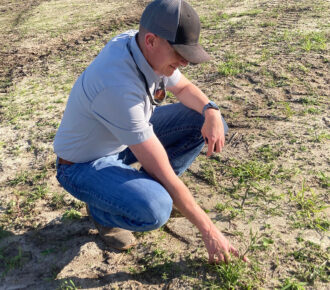
Deseret Cattle & Timber is an early adopter of limpograss in the Florida panhandle, having dabbled with the ‘Floralta’ cultivar since 2017 to improve pastures for pregnant cows. The goal is to plant 3,000 acres of limpograss a year to reach a total of 25,000 acres with this grass.
“When you are managing 3,000-4,000 head of cattle for rotational grazing and you have one tractor, supplementing with hay is not an appropriate strategy,” said Winder. “With limpograss, we can get 4 acres planted from 1 acre of propagated material. That’s a lot of biomass.”
Farmer Howard Hodge, who manages about 200 head of cattle near Marianna, FL, is participating in the SSARE On-Farm Research Grant to test the ‘Gibtuck’ cultivar. He thinks limpograss would make good baleage.
“I wanted to try it and see if I like it. I think it will work and I’ll know in about 20 minutes if my cows like it,” said Hodge, who was in the process of moving baled limpograss to his herd. In the experiment, Hodge had produced 3 bales from an acre of limpograss.
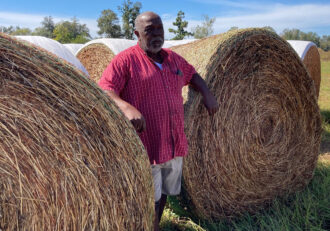
Dubeux said that growing limpograss for baleage is an option, but he’s encouraging farmers to grow the perennial as part of their rotational grazing system.
For the potential limpograss does have as an optional forage crop, there is one drawback, said Dubeux. It cannot be established by seed; it must be propagated vegetatively through sprigging, which does require some initial labor and machinery to get it established.
“Cut it, bale it when wet, haul it to the field you want to establish it in, spread it, roll over it to get good plant to soil contact, and within a few weeks it’ll start to root,” said Dubeux. “Once you do that, you’ve got an established limpograss field that can be used for stockpiling.”
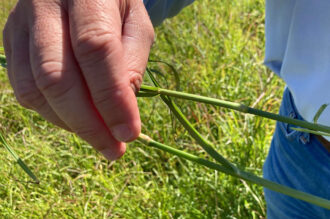
Dubeux is researching the best management practices for grazing limpograss, including how tall the grass should grow before turning cows out on it, and how close to the ground the grass should be grazed. He said it’s the top vegetative portion of the plant, rather than the bottom, stemmy part that holds the most nutritive value.
